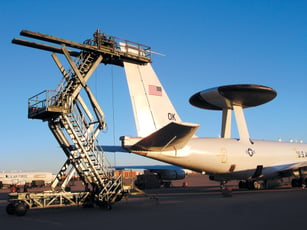 Turnaround time is always important when you’re working with commercial or military aircraft. A commercial plane that’s not in the air isn’t making money. A military helicopter that isn’t combat-ready could jeopardize a mission.
Turnaround time is always important when you’re working with commercial or military aircraft. A commercial plane that’s not in the air isn’t making money. A military helicopter that isn’t combat-ready could jeopardize a mission. At the same time, aviation sites require specialized safety equipment and fall prevention to protect the crew, maintenance personnel and the aircraft itself.
This combination of safety challenges and time pressure makes it particularly important to choose safety solutions designed to also support efficiency. Any equipment you introduce must help workers to complete their tasks safely, without getting in their way.
Choosing The Right Aviation Safety Equipment
Every airport performs some level of maintenance, but these services vary depending on the site’s equipment and capabilities. Typically, a large international airport (such as LAX or JFK) is prepared to perform more complex maintenance tasks than a smaller, regional airport.Since each aviation site has different needs and maintenance capabilities, it’s best to work closely with a vendor to design a custom solution for your facility. Here are a few types of equipment that may be useful within your larger safety solution:
1. Safety Ladders
If your ground crew tends to work with the same type of aircraft in a consistent environment, consider using customized ground maintenance ladders (GMLs) and aircraft maintenance ladders (AMLs). These all-purpose aviation ladders are built to accomodate specific aircraft and worksite conditions, allowing personnel to quickly and safely access areas of the plane that would be impossible with a standard ladder.
2. Crew Access Stands
Similar to AMLs, crew access stands [Link to: http://www.carbissolutions.com/index.php/products/view/crew_access_stands] give your personnel access to your aircraft while minimizing the likelihood of a fatal fall. These stands are set at a specific height to accommodate the doors on most aircraft, and usually have wheels that make them easy to move into place. A well-designed stand protects the crew as well as the exterior of the plane.
3. Adjustable Utility Platforms
Safety ladders and access stands are often good solutions for a site dedicated to maintaining a specific type of plane or helicopter. But some aviation sites must accommodate multiple aircraft types, requiring safe, efficient access to work areas at a variety of heights.
For this situation, your safety solution should include an aerial lift, such as a cherry picker, scissor lift or B-1 stand. These lifts give your personnel access to variable heights, and could eliminate the need for purchasing and storing several types of ladders and stands. Lifts typically use hydraulics to adjust the platform height; more complex loading platforms may be self-propelled.
As you consider possible safety solutions, remember to look for equipment designed to protect your employees and aircraft and maximize your site’s efficiency.
Is your aircraft hangar or facility safe and efficient? Click below to take an online assessment and discover what metrics you need to be tracking for a safer aviation workplace.




